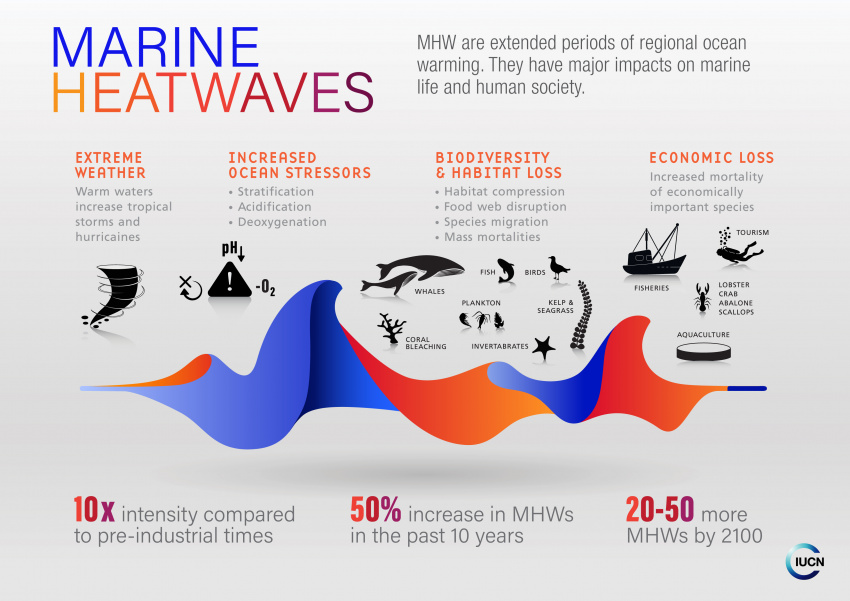14 Jul Marine Heatwave
This article covers “Daily Current Affairs” and the topic details “Marine Heatwave”. The topic “Marine Heatwave” has relevance in the Environment section of the UPSC CSE exam.
For Prelims:
About Marine Heatwaves?
For Mains:
GS 3: Environment
How does Marine Heatwave Impact Rainfall in Northwest India?
What are the other Impacts of Marine Heatwaves?
Why in the news?
The northern Bay of Bengal has been experiencing an intense marine heatwave since June 28, 2023. This has led to India’s usually arid northwest receiving extreme rainfall
What is Marine Heatwave?
- Marine Heatwaves are prolonged periods of anomalously high Sea Surface Temperature (SST).
- These events are linked to coral bleaching, seagrass destruction, and loss of kelp forests, affecting the fisheries sector adversely.
- The most common drivers of marine heatwaves include ocean currents which can build up areas of warm water and air-sea heat flux or warming through the ocean surface from the atmosphere.
- Winds can enhance or suppress the warming in a marine heatwave, and climate modes like El Niño can change the likelihood of events occurring in certain regions.
How does Marine Heatwave Impact Rainfall in Northwest India?
- The marine heatwave in the Bay of Bengal increased sea surface temperatures, causing higher evaporation rates and a greater moisture supply in the atmosphere. This surplus of moisture contributed to above-average rainfall in northwest India.
- The marine heatwave likely influenced the formation and behavior of depressions in the Bay of Bengal, which may have contributed to an increase in the frequency and intensity of depressions, particularly on faster timescales (3-10 days).
- Depressions, which are low-pressure systems, play a significant role in the monsoon and rainfall patterns.
- The marine heatwave, along with changing timescales of depressions, affected the path and trajectory of these weather systems. Depressions tended to move more towards northwest India rather than north-central India, causing a higher concentration of rainfall in the northwest region, leading to above-average rainfall in that area.
What are the other Impacts of Marine Heatwaves?
Affect Ecosystem Structure:Marine heat waves affect ecosystem structure, by supporting certain species and suppressing others.It has been associated with the mass mortality of marine invertebrates and may force species to change behaviour in a way that puts wildlife at increased risk of harm.
Change Habitat Ranges of Certain Species:Marine heatwaves can change the habitat ranges of certain species, such as the spiny sea urchin off southeastern Australia which has been expanding southward into Tasmania at the expense of kelp forests which it feeds upon.
Economic Losses:Marine heatwaves can cause economic losses through impacts on fisheries and aquaculture.
Affect Biodiversity:A study from 2020 (Genesis and Trends in Marine Heatwaves Over the Tropical Indian Ocean and Their Interaction With the Indian Summer Monsoon) reveals that a previous marine heatwave led to bleaching of 85% of corals in the Gulf of Mannar near the Tamil Nadu coast.
Increase the Risk of Deoxygenation and Acidification:
- Often, they occur alongside other stressors such as ocean acidification, deoxygenation, and overfishing.
- In such cases, MHWs not only further damage habitats, but also increase the risk of deoxygenation and acidification.
How does the Bay of Bengal Impact Monsoon?
Moisture Source:
The warm and humid air mass over the Bay of Bengal provides the necessary moisture that is carried by the monsoon winds towards the Indian subcontinent.
Heat Exchange:
The Bay of Bengal has warm sea surface temperatures, especially in its northern part. During the monsoon season, the landmass of the Indian subcontinent gets heated up, creating a low-pressure area. The warm air rises, and cooler air from the Bay of Bengal rushes in to replace it, causing a pressure gradient. This pressure gradient helps draw in moisture-laden winds from the Bay of Bengal, contributing to the monsoon rainfall.
U-Turn of Monsoon Currents:
- The monsoon winds blowing from the southwest over the Arabian Sea cross over into the Bay of Bengal. When they reach the Bay of Bengal, they make a U-turn and start moving towards the northeast, eventually bringing rainfall to different parts of India.
- The warm temperatures in the Bay of Bengal facilitate this U-turn and the transport of moisture to the Indian subcontinent.
Low-Level Jet Stream:
- The Bay of Bengal also influences the formation and intensity of the low-level jet stream, known as the Somali Jet.
- This jet stream plays a significant role in transporting moisture from the equatorial Indian Ocean to the Indian subcontinent, contributing to the monsoon rainfall patterns.
- The warm sea surface temperatures in the Bay of Bengal contribute to the strengthening of this low-level jet, enhancing the moisture supply during the monsoon season.
Q.1 Which of the following statements regarding marine heatwaves in India is/are correct?
- Marine heatwaves have no impact on the formation and behavior of depressions in the Bay of Bengal.
- The warm sea surface temperatures in the Bay of Bengal facilitate the U-turn of monsoon currents and enhance the moisture supply to the Indian subcontinent.
Choose the correct option:
(a) 1 only
(b) 2 only
(c) Both 1 and 2
(d) None of the above
ANSWER: B
Q.2 Which of the following statements regarding marine heatwaves and their impacts is/are correct?
- Marine heatwaves are primarily caused by ocean currents and have no relation to atmospheric conditions.
- Marine heatwaves can result in economic losses by affecting the fisheries and aquaculture industries.
Choose the correct option:
(a) 1 only
(b) 2 only
(c) Both 1 and 2
(d) None of the above
ANSWER:B
Q.3 Discuss the impact of marine heatwaves on marine ecosystems and their consequences for fisheries and aquaculture industries. Examine the factors contributing to the occurrence and intensity of marine heatwaves and suggest measures to mitigate their effects on marine biodiversity and economic activities.




No Comments